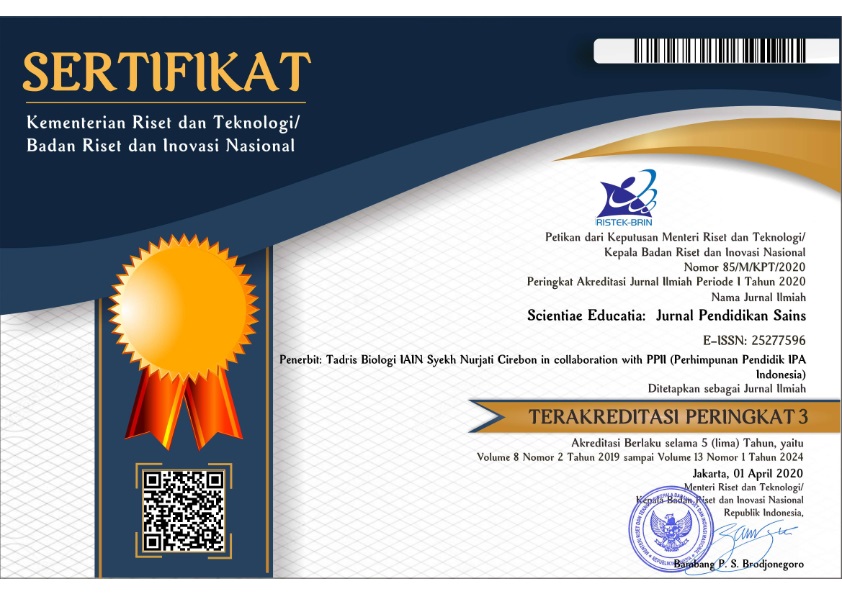The Diversity of Hibiscus rosa-sinensis based on Morphological Approach
(1) Universitas Muhammadiyah Buton
(*) Corresponding Author
Abstract
Keywords
Full Text:
PDFReferences
Ahad, A. H., Yesupadam, P., Ramyasree, P., Suma Padmaja, B., Sravanthi, M., & Guru Prakash, P. (2011). Isolation and physicochemical characterization of Hibiscus rosa-sinensis leaves mucilage. International Journal of Current Research. 3(4): 210–212. ISSN. 0975-833X.
Braglia, L., Nocoletti, F., de Benedetti, L., Pecchioni, N., & A. Mercuri. (2015). Isolation of a Sequence Homolog to more Axillary Branches MAX2 Gene in Hibiscus rosa-sinensis and it use as Genetic Marker. Research in Agriculture and Agronomy. Vol. 2015: 1-36. DOI:10.5171/2015.360263.
Chen M, Choi Y, Voytas DF, & SR. Rodermel. (2000). Mutations in the Arabidopsis VAR2 locus cause leaf variegation due to the loss of a chloroplast FtsH protease. The Plant Journal. 22:303–313. DOI:10.1046/j.1365-313x.2000.00738.x.
Cocciolone SM & K. Cone. (1993). CPl-Bh, an anthocyanin regulatory gene of maize that leads to variegated pigmentation. Genetics. 135 (2):575–588. Available online: https://www.ncbi.nlm.nih.gov/pmc/articles/PMC1205657/pdf/ge1352575.pdf.
Gilman, E.F. (1999). Hibiscus rosa-sinensis. Institute of Food and Agricultural Science, Univrsity of Floryda. 254 1 – 3p.
Hammad, I. (2009). Genetic Variation among Hibiscus rosa-sinensis(Malvaceae) of Different Flower Colors using ISSR an Isozymes. Australian Journal of Basic and Applied Science.3(1): 113 – 125. ISSN 1991-8178.
Henuhili, V. (2007). Pewarisan warna bunga pada anggrek. Seminar Nasional MIPA 2007. 25 Agustus 2007. Yogyakarta, Indonesia.
Kang, H. C., Ha, Y. M., & Kim, K. H. (2015). A New Hibiscus Cultivar ‘Woolred’with Vigorous Growth and Unique Flower Shape Through Interspecific Hybridization. Flower Research Journal.23(4): 276-280. DOI : 10.11623/frj.2015.23.4.45
Karlsson, M., & Werner, J. (2001). Temperature affects leaf unfolding rate and flowering of cyclamen. HortScience. 36(2): 292-294. Available online: http://hortsci.ashspublications.org/content/36/2/292.full.pdf
Kumar, A., Singh, A., College, P., & U. Pradesh. (2012). Review on Hibiscus rosa-sinensis. International Journal of Research in Pharmaceutical and Biomedical Sciences. 3(2): 534–538. Retrieved from www.ijrpbsonline.com.
Kuroda, S., Hakata, M., Hirose, Y., Shiraishi, M., & Abe, S. (2003). Ethylene production and enhanced transcription of an ethylene receptor gene, ERS1, in Delphinium during abscission of florets. Plant Physiology and Biochemistry. 41(9): 812 – 820. DOI: 10.1016/S0981-9428(03)00115-3
Leghari, S.K. and M.A. Zaidi. 2013. Effect of air pollution on the leaf morphology of common plant species of Quetta city. Pak. J. Bot. 45(S1): 447-454. Available online: https://www.pakbs.org/pjbot/PDFs/45(S1)/59.pdf
Magdalita, P. M., Gonzales-Lee, V. R. C., & Pimentel, R. B. (2011). Development and horticultural characteristics of hibiscus hybrids' Women in Public Service Series'. Philippine Journal of Crop Science. 36(2): 56-62. ISSN : 0115-463X
Ma, N., Tan, H., Liu, X., Xue, J., Li, Y., & Gao, J. (2006). Transcriptional regulation of ethylene receptor and CTR genes involved in ethylene-induced flower opening in cut rose (Rosa hybrida) cv. Samantha. Journal of Experimental Botany. 57(11): 2763-2773. DOI: 10.1093/jxb/erl033
Meena, A. K., Jain, A., Pandey, K., &R.K. Singh. (2014). Acute toxicity and genotoxic activity of Hibiscus rosa-sinensis flower extract. American Journal of Phytomedicine and Clinical Therapeutics. 2(4): 524–529. ISSN 2321 – 2748.
Mutui, T. M., Mibus, H., & Serek, M. (2007). Influence of thidiazuron, ethylene, abscisic acid and dark storage on the expression levels of ethylene receptors (ETR) and ACC synthase (ACS) genes in Pelargonium. Plant Growth Regulation. 53(2): 87-96.DOI: 10.1007/s10725-007-9206-y
Nawaz, T., Hameed. M.,Ashraf.M., Al-Qurainy, F., Ahmad, M. S. A., Younis, A& Hayat, M. (2011). Ecological significance of diversity in leaf tissue architecture of some species/cultivars of the genus Rosa L. Pak. J. Bot. 43(2): 873-883. Available online: https://pdfs.semanticscholar.org/28eb/235c3f6bb7b52452f72707cd58476280925b.pdf
Noman, A., Hameed, M., Ali, Q., & Aqeel, M. (2012). Foliar tissue architectural diversity among three species of genus Hibiscus for better adaptability under industrial environment. International Journal of Environmental Sciences. 2(4): 2212-2222. DOI:10.6088/ijes.00202030104
Noman, A., Ali, Q., Hameed, M., Mehmood, T& Iftikhar, T. (2014). Comparison of leaf anatomical characteristics of Hibiscus rosa-sinensis grown in Faisalabad region. Pakistan Journal of Botany. 46(1): 199-206. ISSN: 0556-3321
Oktiarni, D., Ratnawati, D., & B. Sari. (2013). Pemanfaatan Ekstrak Bunga Kembang Sepatu (Hibiscusrosa-sinensis Linn.) sebagai Pewarna Alami dan Pengawet Alami Pada Mie Basah. Prosiding Semirata FMIPA Universitas Lampung, 103–110.Available online:jurnal.fmipa.unila.ac.id/index.php/semirata/article/download/798/617.
Raduan, S. Z., Abdul Aziz, M. W. H., Roslida, A. H., Zakaria, Z. A., Zuraini, A., &M.N. Hakim. (2013). Anti- inflammatory effects of Hibiscus rosa-sinensis L. and Hibiscus rosa-sinensis var. alba ethanol extracts. International Journal of Pharmacy and Pharmaceutical Sciences. 5(4): 754–762. ISSN: 0975-1491.
Rukmana, R. (2002). Bunga Raya. Kanisius. Yogyakarta. 39p.
Shaheen, N., M. Ajab, M.Q. Hayat and G. Yasmin, 2009. Diversity of Foliar trichomes and their systematic relevance in the genus Hibiscus (Malvaceae). International Journal of Agriculture and Biology. 11(3): 279–284. ISSN Online: 1814–9596.
Suryowinoto, S.M. (1997). Flora Eksotika. Tanaman Hias berbunga. Penerbit Kanisius. Yogyakarta.
Trivellini, A., A. Ferrante., P.Vernieri., G. Serra. (2011a). Effects of Promoters and Inhibitors of Ethylene and ABA on Flower Senescence of Hibiscus rosa-sinensis L. Journal of Plant Growth Regulation. 30 (2): 175 – 184. DOI: 10.1007/s00344-010-9181-9
Trivellini, A., A. Ferrante., P.Vernieri., G. Serra. (2011b). Effects of abscisic acid on ethylene biosynthesis and perception in Hibiscus rosa-sinensis L. flower development. Journal of Experimental Botany. 62(15): 5437–5452. DOI: 10.1093/jxb/err218.
Van Steenis, C.G.G.J. (2003). Flora. P.T. Pradya Paramita, Jakarta. ISBN: 9789794081143
Viscosi V, Lepais O, Gerber S, Fortini P. (2009). Comparison of leaf morphological analysis in four species and hybrids of the European white oak complex. Plant Biosyst. 143: 564–574. DOI:10.1080/11263500902723129
Wang, Q. M., Wang, L., Zhou, Y., Cui, J., Wang, Y., &C. Zhao. (2016). Leaf patterning of Clivia miniata var. variegata is associated with differential DNA methylation. Plant Cell Reports. 35(1): 167–184. DOI:10.1007/s00299-015-1877-7
Warner, R.M and J.E. Erwin. (2001). Variation in Floral Induction Requirements of Hibiscus sp. Journal of the American Society for Horticultural Science. 126(3): 262–268. Available online: http://journal.ashspublications.org/content/126/3/262.full.pdf
Warner, R. M., & Erwin, J. E. (2003). Effect of photoperiod and daily light integral on flowering of five Hibiscus sp. Scientia Horticulturae. 97(3-4): 341-351. DOI: 10.1016/S0304-4238(02)00157-7
Zubairi, S. I., & N.S. Jaies. (2014). Daun Hibiscus rosa sinensis: Analisis proksimat, aktiviti antioksidan dan kandungan bahan inorganik. Malaysian Journal of Analytical Sciences.18(2): 260–270. Available online: http://www.ukm.my/mjas/v18_n2/SaifulIrwan_18_2_5.pdf
DOI: 10.24235/sc.educatia.v7i1.2503
Article Metrics
Abstract view : 1436 timesPDF - 1200 times
Refbacks
- There are currently no refbacks.
Scientiae Educatia: Jurnal Pendidikan Sains indexed by:

This work is licensed under a Creative Commons Attribution 4.0 International License.
Stat Counter (Link)



1.png)












